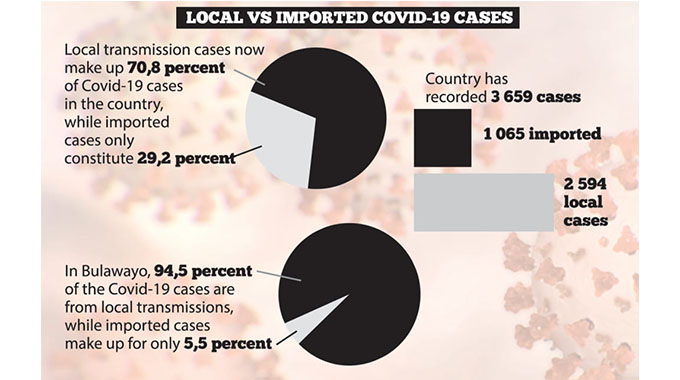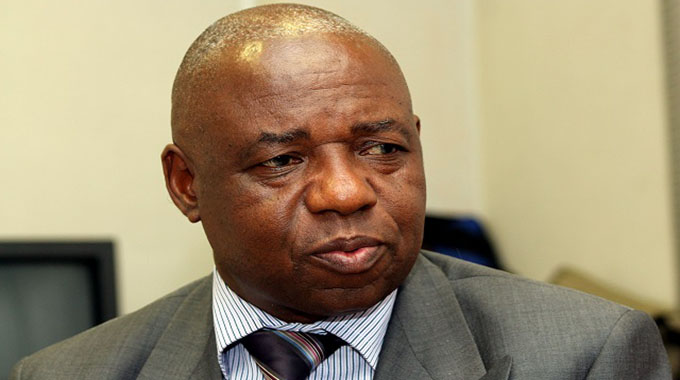Local transmissions constitute 95% of Bulawayo Covid-19 cases

Andile Tshuma, Chronicle Correspondent
LOCAL Covid-19 transmissions have risen alarmingly in the country, constituting more than 70 percent of all cases, while they make up 94,5 percent of Bulawayo’s infections.
This comes at a time when 69 people have been killed by the virus in the country, with the total number of cases rising to 3 659.
Bulawayo and Harare remain the worst affected provinces, followed by Matabeleland South and the Midlands provinces.
The 132 535 Covid-19 tests that had been conducted by Saturday comprised 70 958 Rapid Diagnostic tests (RDT) and 61 577 Polymerase Chain Reaction (PCR) tests.
The positivity rate, calculated by dividing the total number of tests conducted by the number of positive results, for the combined PCR and RDT tests is one positive case in every 36 people tested. Two weeks ago, the positivity rate was one in every 60.
One in every 19 people has tested positive for Covid-19 when using the RDT while one in every 19 people has tested positive for Covid-19 when using the PCR figures.
Two weeks ago, one in every 35 people had tested positive for Covid-19 when using the RDT while one in every 24 people had tested positive for Covid-19 when using the PCR figures. Local transmission cases now make up 70, 8 percent of Covid-19 cases in the country, while imported cases only constitute about 29 percent.
In Bulawayo, 94,5 percent of the Covid-19 cases are from local transmissions, while imported ones make up for only 5,5 percent.
To date, the country has recorded 1 065 imported cases and 2 594 local cases.
The manifestation of Covid-19 has been changing since the country recorded its first case on March 20 when cases were mainly reported from individuals with a travel history.
After a few weeks, infections started being concentrated at quarantine centres accommodating returning residents mainly from South Africa, Botswana and Mozambique.
The number of local transmissions started rising later, with the highest numbers of local transmissions being reported on August 1.
Last month, the country witnessed a dramatic change as it started recording an increase in local transmissions which were partly attributed to positive individuals escaping from quarantine centres and other people knowingly or unknowingly spreading the virus by not taking preventive measures such as self-isolation.
Workplaces, hospitals and prisons have become Covid-19 epicentres, a disturbing trend given that most victims at hospitals and prisons are the Covid-19 frontliners while productive workers at the different companies who are supposed to produce for the nation are under threat as well. Health experts said an analysis of how Covid-19 has spread in the country shows that the virus had been handled well at the onset but the situation changed recently as contact tracing is now complicated.
Mpilo Central Hospital Acting Chief Executive Officer Professor Solwayo Ngwenya said the figures on local cases were not surprising as they mirrored public behaviour towards the pandemic.
“Those figures, while worrying should not come as a surprise. They are just showing the people’s behaviour and indifference about the virus. If people do not change their ways, then we will see worse figures, and more deaths reported. People must listen. Deaths are already increasing as we are seeing daily, what more do people need to be convinced to stay at home. We have allowed the virus to penetrate, and over the next weeks, we should expect to see more cases, and deaths too. But with behaviour change, we could slow the tide,” he said.
Last week, Bulawayo medical practitioner, Dr Anele Bhebhe said the Covid-19 fight had started well in the city, although action against the pandemic had deteriorated.
“Initially we started on the right foot but people became lax as though we were now Covid-19 free hence the dramatic rise in cases recently. Preventive protocols stopped being followed because of fatigue. Most cases recorded during the first few days and weeks of the outbreak in March were associated with people who had travelled and as such locals felt safe. The pandemic’s manifestation has however been evolving and at one time the spike in cases was witnessed at quarantine centres where most of those testing positive were returnees. The situation has changed during the past few weeks as the country is now witnessing more local or community transmission compared to imported cases,” said Dr Bhebhe. — @andile_tshuma












Comments